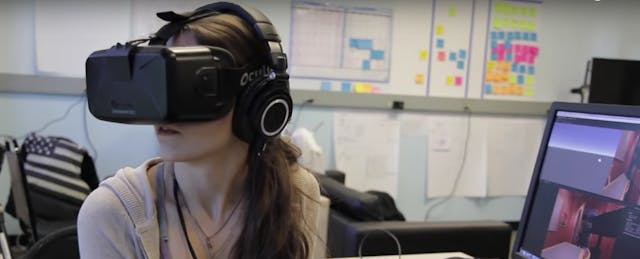The headlines and stories about the real adoption of virtual reality (VR) in higher education emphasize that it’s not quite ready for prime time and hasn’t been for more than two decades since it started streaming over the early iterations of headsets back in the early 90s. While widespread adoption remains to be seen at colleges and universities, virtual reality research and development is being driven by passionate students who are working in a kind of Wild West of intense experimentation.
One place where students are literally immersed in VR is at Carnegie Mellon University’s Entertainment Technology Center (ETC). ETC offers a two-year Master of Entertainment Technology program (MET) launched in 1998 and cofounded by the late Randy Pausch, author of “The Last Lecture.”
MET starts with an intense boot camp called the “immersion semester” in which students take a Building Virtual Worlds (BVW) course, a leadership course, along with courses in improvisational acting, and visual storytelling. Pioneered by Pausch, BVW challenges students in small teams to create virtual reality worlds quickly over a period of two weeks, culminating in a presentation festival every December.
“The immersion semester was the most fun I ever had in my life that I would never do again,” says 24-year-old MET student Brian Beebe. “It was a phenomenal learning experience where I honestly never slept. We worked weekends, too.”
The remaining MET curriculum features three semester-long interdisciplinary team projects. Since the program admitted its first class of students in the fall of 1999, more than 700 graduates have created numerous electronic games, digitally themed entertainment experiments, and a host of sophisticated augmented and virtual reality experiences through these projects.
Anywhere from one-quarter to one-third of all the MET interdisciplinary team projects, of which there are typically anywhere from 15 to 22 projects each spring and fall semester, are either VR or augmented reality related, ETC Director Drew Davidson says. “We believe there are ways to use the full range of media to help with education, and VR is really big right now,” he adds. “Five years ago virtual reality was just something we did, but now it is so hot; it is popping up everywhere. We do a lot [in VR] not only with computer graphics but also with film.”
Learning through creating emotional experiences
Beebe is currently working as the cinematic producer of an interdisciplinary project called Feelsbot with three fellow MET students at ETC’s Silicon Valley satellite campus housed at the headquarters of Electronic Arts in Redwood City, California. Feelsbot, which is sponsored through ETC’s partnership with Electronic Arts, is an audio-narrative exploration where users experience an emotional story of a father and a daughter seeking reconciliation after a broken relationship. The virtual reality experience happens inside a mysterious interdimensional machine that travels back in time to explore their connection to each other.
“We are telling an emotional story, driven by a linear narrative inside a virtual reality,” Beebe explains. “We had our own take on what we wanted to do and EA said ‘make an emotional experience using virtual reality. Whatever you want to do, just do it.’”
Ultimately Beebe and his team “want users to relate to these characters,” he says. “We want them to feel immersed in this world and feel that these characters are real and believable. We are trying to get an emotional reaction by the end.”
A closer look at some of the other student-run ETC projects provides a peek into a wide variety of virtual reality experiences. One called “Injustice,” created by another MET student team known as Kalpana, has recently drawn attention. The three-to five-minute experience is themed around racially motivated police brutality. As the site explains, “guests witness an act of racial discrimination happening in front of them, forcing them to make moral and ethical decisions on the spot.”
VR’s uncertain future
Jesse Schell, ETC professor, CEO of Schell Games and former creative director for Disney’s Imagineering Virtual Reality Studio has been working in the field since 1992 and has been teaching the BVW course for 14 years. “Virtual simulations will multiply the power of digital simulations tenfold,” he says, adding that “students will get tremendous benefit making and sharing their own virtual reality worlds.”
Schell does not believe, however, that the development and adoption of VR-oriented courses in colleges and universities will happen anytime soon. “We are uncertain whether there is a market in higher education,” as opposed to a more accepting market in K-12 already happening, Schell explains when putting on his CEO hat. “We find higher education to be a difficult market that is somewhat hard to penetrate.”
Despite slow adoption rates for VR’s use inside higher education courses, “possibly the best way to use virtual reality in education is to use it as a medium of creation, to have students create virtual reality experiences and share them with each other,” Schell says. Instead of having students writing reports and creating Powerpoint presentations, “why not have students make virtual reality to illustrate a point or help get people engaged? It won’t be the professors or the technical companies leading the way, it will be the students leading the way by being the ones who create and invent in this new medium.”


